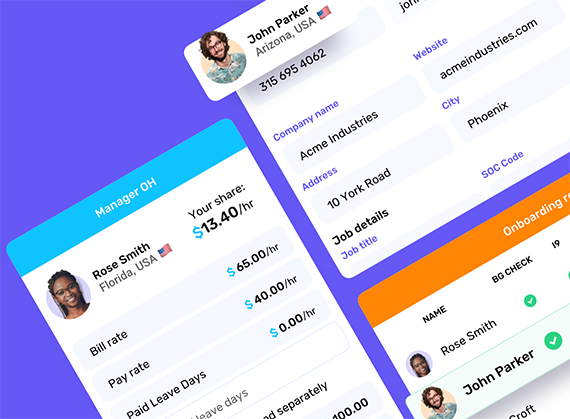Determining how much to charge clients for contract staffing services extends beyond a contractor’s wages. For some recruiters, setting a contract bill rate can be a challenge. There are many things to think about like the state of the market, your competition, your margin, and how much your contractor is going to be making. But once you know what goes into it, learning how to calculate the bill rate isn’t difficult. It could be even easier using an instant quote tool like FoxHire’s but we can get to that later!
What is a bill rate?
What does billing mean in recruitment? Your bill rate is how much you charge your client when you place a contract worker at their company. This is usually thought of as an hourly or a weekly rate.
Your bill rate should cover the contract worker’s wage (hourly pay rate), taxes and insurance, administrative expenses, and leave room for a decent profit margin for your staffing firm.
Bill rate vs. pay rate
Unlike a bill rate, the pay rate only applies to the contract worker’s wage (hourly or weekly rate). Pay rate is how much you pay the contract worker. It does not include other costs of employing the worker like taxes and insurance, or your recruiter fees (profit).
Calculating contract bill rates
Determining your bill rate might seem intimidating, but it doesn’t have to be. First, let’s look at what makes up the hourly bill rate:
Hourly Bill Rate = Hourly Pay Rate + Tax Burden + G&A (aka Back-Office) + Recruiter Profit
Try using the following three-step process to select a fair and profitable bill rate.
1. Get a bill rate range from client
What is your client’s hiring budget? Having a rough idea of what your client is willing to pay shows you if you are in the same ballpark as you work through the rest of this process. They could give you this budget in the form of a hourly dollar amount, like “$50 per hour”. They may also give you a budget in the form of a markup, or the percentage of the pay rate you are allowed to “tack on” the top to make a profit. This may sound something like, “We are willing to do a 56% markup on contract roles like this”. Either way, this will give you a starting point to begin your calculation.
2. Determine the contract worker’s pay rate
The largest part of the contract bill rate is what the contract worker will be paid on an hourly basis. Therefore, the pay rate is a good starting point when calculating a proposed bill rate.
You can ask an experienced contract worker what their expected pay rate is. You can usually determine whether that is reasonable based on their education, experience, skill set, etc.
If your candidate is new to contracting, figure out how much someone in a similar position earns. You can find competitive salary ranges by looking at the United States Bureau of Labor Statistics. Once you have a salary, you can convert salary wages to an hourly pay rate. To do so, divide the salary by the average number of working hours per year, which is 2,080. This does not take overtime into consideration.
Keep in mind that other factors affect a worker’s hourly pay rate, including:
- Assignment length: Short-term contracts generally demand higher pay rates
- Conversion potential: The pay rate can be closer to a direct salary if the position is likely to convert
- Benefits: The pay rate might be lower if the worker receives generous benefits like health insurance and retirement plans
3. Apply a multiplier (mark-up)
Once you have determined the hourly pay rate, you can use an average multiplier to calculate the company’s bill rate. As of May 2021, the current average multiplier is 1.56 (or 56%). Multipliers vary based on factors like location and industry.
When you decide on the mark-up, multiply it by the contract worker’s hourly pay rate to come up with the proposed bill rate.
Let’s say you want to pay a contract worker $45.00 per hour. Use the average multiplier of 1.56 to find your bill rate:
$45.00 (Hourly Pay Rate) X 1.56 (Multiplier) = $70.20 (Bill Rate)
You would bill your client $70.20 per hour.
This video from our President, Colin LaBeau explains:
What does the mark-up cover?
The margin between the pay rate and the bill rate covers the tax burden, general and administrative costs, and your recruiter profit.
Because you are the contractor’s W-2 employer of record, you are responsible for handling taxes and insurance. You are responsible for withholding income, Social Security, and Medicare taxes from the worker’s wages. And, as the employer, you must also contribute Social Security and Medicare taxes. Plus, you must obtain workers’ compensation insurance. These costs in your bill rate markup.
General and administrative costs can add up, too. These costs are associated with the legal, financial, and administrative duties of placing contract workers.
The remainder of the margin after the tax burden and G&A is your recruiter profit. Obviously, the wider the margin between the contractor pay rate and the company bill rate, the more profit there will be.
Calculating all the rates and handling taxes and workers’ compensation are all part of the contract staffing model and fall into “back-office” duties. Plus, there are often more duties associated with offering benefits.
How to avoid the back-office duties
If you’re like most recruiters, you’ll want to know how to avoid the stress associated with becoming a contractor worker’s W-2 employer of record. An easy solution is to let FoxHire take care of the back-office tasks for you!
Our contract staffing back-office solution will help you with rate calculations, and handle all the legal, financial and administrative responsibilities so you can focus on recruitment. Use the FoxHire customizable contractor rate calculator to see how much your profits would be using our premium or express services.





